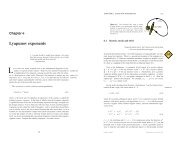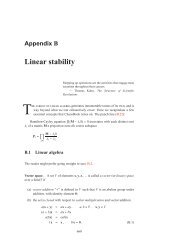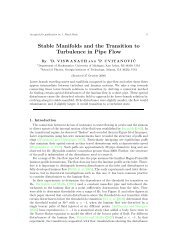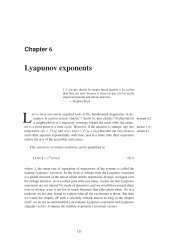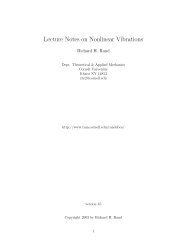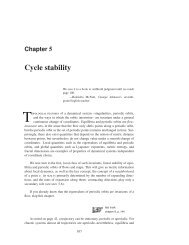10 Circle Maps: Irrationally Winding - Center for Nonlinear Science
10 Circle Maps: Irrationally Winding - Center for Nonlinear Science
10 Circle Maps: Irrationally Winding - Center for Nonlinear Science
You also want an ePaper? Increase the reach of your titles
YUMPU automatically turns print PDFs into web optimized ePapers that Google loves.
16 P. Cvitanovic<br />
In the crudest approximation, one can replace P=Q in (28) by a \mean" value<br />
^ in that case the sum is given explicitely by a ratio of the Riemann -functions:<br />
(31)<br />
() =<br />
1X<br />
Q=1<br />
(Q) Q 2 ^ =<br />
(;2 ^ ; 1)<br />
(;2 ^)<br />
As the sum diverges at ; = Hausdor dimension, the \mean" scaling exponent<br />
^ and D H are related by the function pole at (1):<br />
(32)<br />
D H ^ = 1:<br />
While this does not enable us to compute D H , it does immediately establish that<br />
D H <strong>for</strong> critical maps exists and is smaller than 1, as the bounds (18) yield<br />
(33)<br />
2<br />
3 < D H < :9240 :::<br />
To obtain sharper estimates of D H , we need to describe the distribution of<br />
P=Q within the bounds (18). This we shall now attempt using several variants<br />
of the thermodynamic <strong>for</strong>malism.<br />
<strong>10</strong>.<strong>10</strong> The Hausdor Dimension in Terms of Cycles<br />
Estimating the n ! 1 limit of (30) from nite numbers of covering intervals<br />
`i is a rather unilluminating chore. Fortunately, there exist considerably more<br />
elegant ways of extracting D H . We have noted that in the case of the \trivial"<br />
mode-locking problem (2), the covering intervals are generated by iterations of<br />
the Farey map (<strong>10</strong>) or the Gauss shift (11). The nth level sum (30) can be<br />
approximated by L n , where L(y x) = (x ; f ;1 (y))jf 0 (y)j this amounts to<br />
approximating each cover width `i by jdf n =dxj evaluated on the ith interval. By<br />
nothing much deeper than use of the identity log det = tr log, the spectrum of L<br />
can be expressed[31] in terms of stabilities of the prime (non-repeating) periodic<br />
orbits p of f(x):<br />
(34)<br />
X z rnp j r pj <br />
det(1 ; zL) = exp ;<br />
p r 1 ; 1= r<br />
Y r=1<br />
p<br />
1Y <br />
= 1 ; z<br />
n p<br />
j p j = k p :<br />
p<br />
k=0<br />
In the \trivial" Gauss shift (11) renormalization model, the Fredholm determinant<br />
and the dynamical zeta functions have been introduced and studied by<br />
Mayer[51] who has shown that the eigenvalues of the transfer operator are exponentially<br />
spaced, just as <strong>for</strong> the dynamical zeta functions[52] <strong>for</strong> the \Axiom A"<br />
hyperbolic systems.<br />
The sum (30) is dominated by the leading eigenvalue of L the Hausdor<br />
dimension condition Z n (;D H ) = O(1) means that = ;D H should be such<br />
1X<br />
!



